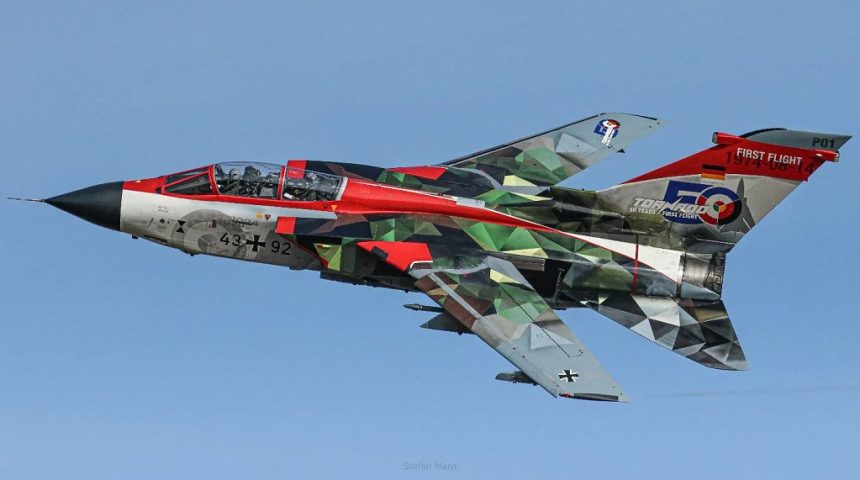The aircraft will be officially presented during this year’s ILA Berlin airshow.
Airbus unveiled a Luftwaffe Tornado IDS with a new special livery for the 50th anniversary of the first flight of the European aircraft. The Tornado, with codes 43+92, is assigned to Taktisches Luftwaffengeschwader 33 at Buchel air base and shows elements from the past with a look to the future, as it combines parts of the prototype’s red and white livery, the grey livery currently used by the German Air Force and a splinter camo which reminds the old green camo.
In addition to that, the Tornado logo is accompanied by the “50 years first flight” writing over a combination of the Italian, British and German roundels, the founding members of the tri-national Tornado consortium, which were later joined by Saudi Arabia. Today, the Tornado is still operated by the German Luftwaffe, the Italian Aeronautica Militare and the Royal Saudi Air Force, while the UK’s Royal Air Force retired it in 2019.
A sight for sore eyes 😍 @Team_Luftwaffe and #TeamAirbus just rolled out a special aircraft for a special occasion in Manching – our Tornado, sporting the “50 Years First Flight” special livery.
On 14 August 1974, it took off for the first time and since 1980 has always been on… pic.twitter.com/5YPgVtYYLm
— Airbus Defence (@AirbusDefence) March 21, 2024
This special color will be officially presented during this year’s International Aerospace Exhibition (ILA) Berlin airshow from June 5 to 9, ahead of the first flight’s anniversary on August 14. The aircraft will return in Manching, where the first flight took place, in September for the official celebration.
The Panavia Tornado
With over 950 aircraft built, the variable sweep bomber is the largest European aeronautical cooperation program, followed today by the Eurofighter Typhoon. The four partner nations accumulated more than three million flight hours, including combat flights in all the modern conflicts.
Born in the 1960s as the Multi Role Combat Aircraft (MRCA), the Tornado was designed as a twin-engine supersonic twin-seat bomber, with all-weather and low flight capabilities and a distinctive variable sweep wing. The aircraft went on also with a very capable electronic combat variant (ECR) and an air defense variant (ADV).
The three biggest names in the aerospace industry in Great Britain, Germany and Italy – the British Aircraft Corporation (now BAE Systems), FIAT Aviazione (which went on to become Aeritalia, then Alenia Aermacchi, and is now Leonardo), and MBB (now Airbus DS) – joined forces in the project. The partnership established the Panavia consortium and laid the foundations for the birth of a true European aeronautical industry, which went on to establish the Eurofighter programme.
The Luftwaffe operated three variants of the Panavia Tornado since 1980, when the type entered operational service with the Tornado IDS and IDS(T) (trainer) variants, joined in 1990 by the Tornado ECR. The German Navy also operated the IDS variant until 2005, when they were transferred to the Air Force. In total, Germany had 357 aircraft, of which 255 Tornado IDS, 67 Tornado IDS(T) and 35 Tornado ECR.
Visualizza questo post su Instagram
Italy operates three variants of the aircraft, which increased to four for decade in the 1990s. In fact, the Aeronautica Militare began operations in 1981 with 87 Tornado IDS and 12 Tornado IDS(T), which were joined in 1993 by 24 Tornado F3 leased by the UK and in 1998 by 16 Tornado ECR converted from IDS models. Both Italy and Germany plan to retire their Tornado aircraft in 2025 and replace them with the F-35A.
Saudi Arabia, the only export customer of the European aircraft, operated the most variants among the partner nations. In fact, since 1989, the country fielded 60 Tornado IDS, 24 Tornado IDS(T), 12 Tornado IDS(R) (Reconnaissance), 18 Tornado ADV and six Tornado ADV(T). The latter two variants are now retired, however it is not known how long the other variants will be kept in operations before being replaced by the Eurofighter Typhoon and the F-15SA.
The Royal Air Force, the only service to completely retire the type so far, received 230 Tornado IDS/GR1, of which 142 later upgraded to GR4, 18 Tornado F2 and 147 Tornado F3. The air defense variants were retired in 2011, while the ground attack variants were retired in 2019.
Visualizza questo post su Instagram
Thanks to Stefan Mans and A.B Aviationphotography for the photos they sent us and make sure to follow them on Instagram for more!









